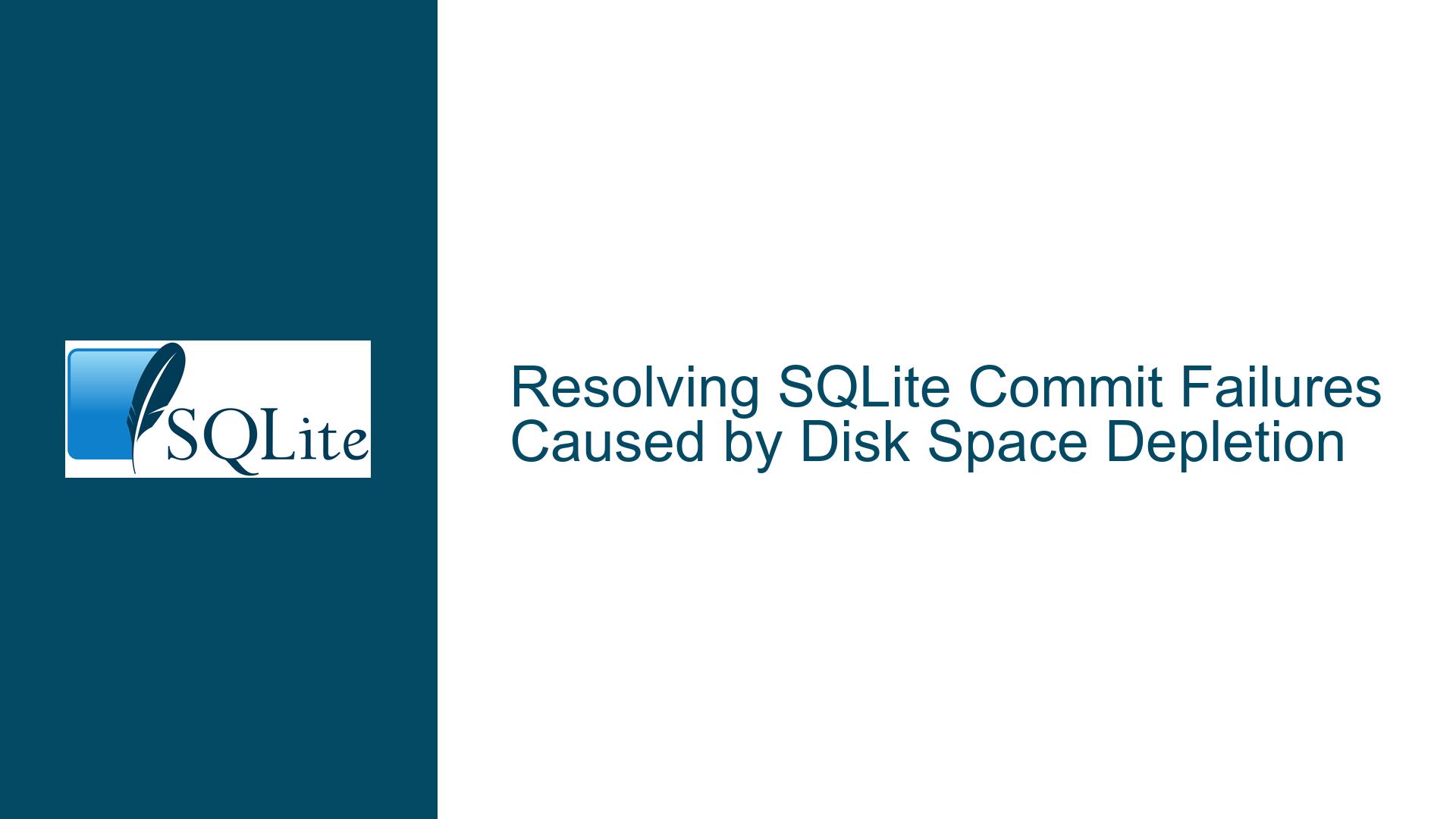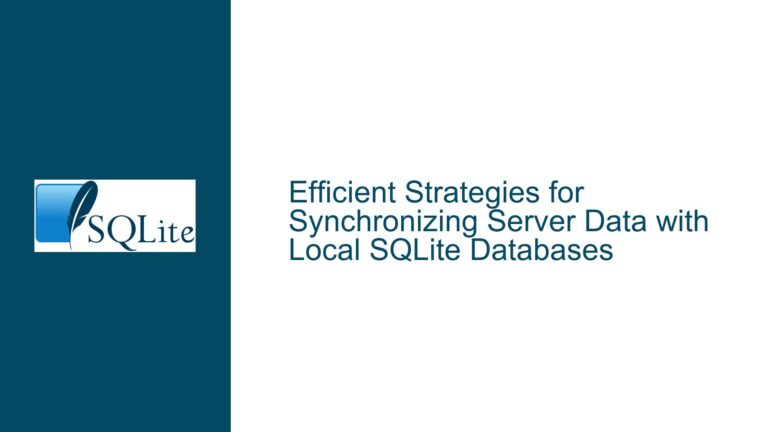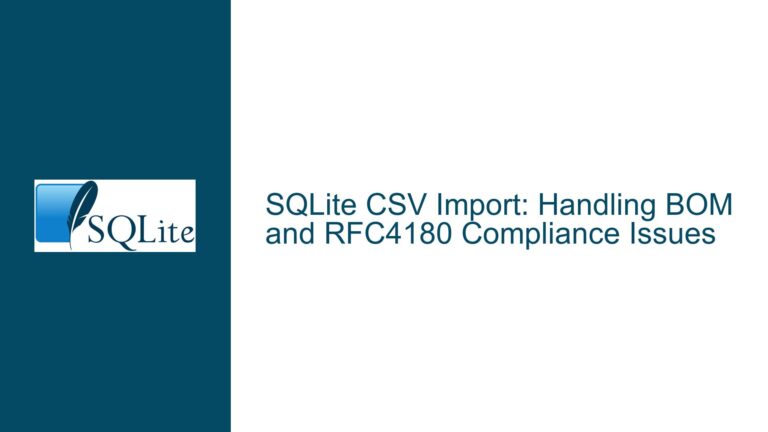Resolving SQLite Commit Failures Caused by Disk Space Depletion
Issue Overview: Diagnosing Disk-Related Commit Errors in SQLite
When SQLite encounters a failure during a transaction commit operation, developers often rely on its error codes to determine the root cause. A common scenario involves commit failures due to insufficient disk space. However, SQLite does not inherently monitor disk space availability. Instead, it propagates errors generated by the operating system’s I/O layer. The challenge arises when SQLite returns a generic SQLITE_ERROR instead of more specific error codes like SQLITE_FULL or SQLITE_IOERR_WRITE, leaving developers uncertain whether the failure stems from disk exhaustion or another issue.
SQLite’s transactional model requires writing data to a journal file (in rollback journal mode) or a Write-Ahead Logging (WAL) file before finalizing changes in the main database file. If the storage subsystem reports an I/O error during this process—such as when the disk is full—SQLite translates this into an error code. However, the mapping between OS-level errors (e.g., ENOSPC on Unix-like systems) and SQLite’s error codes depends on the Virtual File System (VFS) layer. Not all VFS implementations expose disk space exhaustion with granularity, leading to ambiguity in error reporting. For example, a misconfigured VFS might mask ENOSPC as a generic I/O error instead of SQLITE_FULL.
The confusion intensifies when extended error codes are enabled but fail to provide clarity. Developers may assume SQLITE_ERROR is a catch-all code, but in reality, SQLite’s error taxonomy includes specific codes like SQLITE_FULL (database or disk full) and SQLITE_IOERR_WRITE (write failure). These codes are contingent on the underlying system’s ability to communicate the cause of I/O failures. If the OS or VFS does not propagate low-level error details, SQLite cannot reliably distinguish between disk space exhaustion and other I/O faults.
Possible Causes: Why Disk Space Failures Manifest as Ambiguous Errors
1. VFS Layer Abstraction Limitations
SQLite’s VFS layer abstracts platform-specific I/O operations, allowing portability across operating systems. However, this abstraction can obscure the root cause of I/O errors. For instance, a VFS implementation on Windows might translate ERROR_DISK_FULL to SQLITE_FULL, while a custom VFS on an embedded system might lack the logic to map ENOSPC to the correct SQLite error code. If the VFS returns a generic I/O error, SQLite will surface it as SQLITE_IOERR without further differentiation.
2. Transaction Journaling Overhead
SQLite’s transactional integrity mechanisms require temporary storage for journal files or WAL segments. When a transaction is committed, the database engine must write both the main database file and its journal/WAL file. If the disk space is nearly full, the commit operation might fail during the journal write phase, even if the main database file has sufficient space reserved. This interdependency complicates error attribution, as the failure could occur at multiple stages: journal creation, WAL expansion, or database page modification.
3. File System and Storage Subsystem Caching
Modern file systems employ write-back caching, where I/O operations are acknowledged before data is physically written to storage. If the disk fills up during a cached write, the error might be reported asynchronously, leading to delayed or inconsistent error propagation. SQLite’s synchronous modes (e.g., PRAGMA synchronous=FULL) mitigate this risk but cannot eliminate it entirely. A commit might initially succeed in the file system cache but later fail during cache flushing, resulting in an SQLITE_IOERR without a clear link to disk space exhaustion.
4. Resource Contention in Multi-Process Environments
In scenarios where multiple processes or threads access the same database, external processes might consume disk space concurrently with an active SQLite transaction. For example, a backup process writing to the same disk could exhaust free space during SQLite’s commit phase. SQLite has no visibility into such external factors, so the resulting I/O error will not explicitly indicate disk space depletion unless the OS provides that context.
5. Misconfiguration of Database Limits
SQLite enforces internal limits, such as the maximum number of attached databases or the size of in-memory databases. While SQLITE_FULL typically denotes disk space issues, it can also indicate that a database has reached its configured maximum size (e.g., when using sqlite3_file_control(SQLITE_FCNTL_SIZE_LIMIT)). Developers might misinterpret this as a disk-related error when the constraint is logical rather than physical.
Troubleshooting Steps, Solutions & Fixes: Mitigating Disk-Related Commit Failures
Step 1: Enable Extended Error Codes and Inspect Context
Activate SQLite’s extended error code support to differentiate between generic and specific I/O errors. In C/C++, use sqlite3_extended_result_codes(db, 1);. For other languages, consult the binding’s documentation (e.g., in Python, set detect_types=sqlite3.PARSE_COLNAMES). After a failed commit, retrieve the extended error code using sqlite3_extended_errcode(). If the code is SQLITE_FULL (13) or SQLITE_IOERR_WRITE (266), disk space exhaustion is likely the culprit. However, cross-validate this by querying the OS for available disk space immediately after the error occurs. On Unix-like systems, use statvfs(); on Windows, call GetDiskFreeSpaceExW().
Step 2: Implement Proactive Disk Space Monitoring
Before initiating large transactions, estimate the required disk space by analyzing pending changes. For example, if inserting 1,000 rows with an average row size of 1 KB, reserve at least 1 MB plus overhead for journaling. Use OS APIs to check free space and compare it against the estimated requirement. If insufficient, abort the transaction early and notify the user. Be aware that this approach is not foolproof due to potential race conditions (e.g., another process consuming disk space after the check but before the commit).
Step 3: Configure SQLite for Resilient Storage Handling
Adjust SQLite’s pragmas to minimize the risk of disk-related commit failures:
- Set
PRAGMA journal_mode = WAL;to reduce disk space fragmentation and improve write concurrency. - Use
PRAGMA auto_vacuum = INCREMENTAL;to reclaim free pages periodically, preventing database bloat. - Increase
PRAGMA page_size;to match the underlying storage’s block size, reducing I/O overhead.
If SQLITE_FULL errors persist, consider attaching a temporary database on a different storage device with sufficient space and offloading data using ATTACH DATABASE and INSERT INTO ... SELECT ....
Step 4: Handle Errors Gracefully with Retry Logic
When a commit fails with SQLITE_FULL or SQLITE_IOERR_WRITE, implement a retry mechanism with exponential backoff. For example:
- Roll back the current transaction using
ROLLBACK;. - Invoke the OS’s disk space check to confirm availability.
- If space is insufficient, prompt the user to free storage or expand the disk.
- Retry the transaction after a delay, reducing its scope (e.g., batching inserts into smaller chunks).
For applications without user interaction (e.g., servers), log the error and queue the transaction for later execution.
Step 5: Audit VFS and File System Interactions
If using a custom VFS, verify that it correctly propagates OS-level error codes. For example, ensure that ENOSPC (Unix) or ERROR_DISK_FULL (Windows) maps to SQLITE_FULL. Test the VFS by artificially limiting disk space (e.g., with ulimit -f on Linux or disk quotas on Windows) and observing the error codes returned. If the VFS is non-configurable, supplement SQLite’s error handling with platform-specific I/O diagnostics, such as parsing errno or GetLastError() after a failed commit.
Step 6: Optimize Database Schema and Queries
Reduce disk space consumption by optimizing data types and indexing strategies:
- Replace
TEXTwithBLOBfor non-UTF8 data to avoid encoding overhead. - Use
INTEGER PRIMARY KEYfor row IDs to prevent unnecessary index duplication. - Employ
VACUUM;periodically to defragment the database file.
For append-only workloads, consider using time-partitioned databases or offloading historical data to external storage.
Step 7: Leverage Operating System Features for Storage Management
Configure the OS to prioritize SQLite’s storage needs:
- On Linux, use
cgroupsto reserve disk space for the database process. - On Windows, enable write throttling with
SetThreadPriority(THREAD_MODE_BACKGROUND_BEGIN);during bulk inserts. - On cloud platforms, enable automatic disk expansion or integrate with storage APIs that trigger alerts when free space falls below a threshold.
Step 8: Instrumentation and Logging
Embed diagnostics into the application to capture disk space metrics, SQLite error codes, and transaction details at the time of failure. For example, log the size of the database file, active journal/WAL files, and OS-reported free space. Cross-reference these logs with SQLite’s sqlite3_status() counters (e.g., SQLITE_STATUS_MEMORY_USED) to identify memory pressure that could exacerbate disk I/O issues.
By systematically applying these strategies, developers can mitigate disk-related commit failures, improve error diagnostics, and ensure robust transaction handling in SQLite-based applications.






